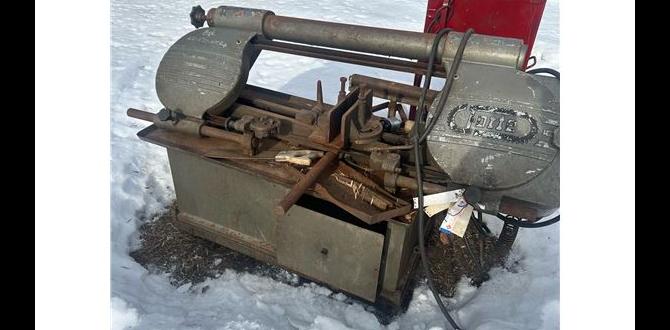Quick Summary: Nail curving during shooting is most often caused by improper nail gun setup, the type of material being fastened, or issues with the nail gun itself. Adjusting air pressure, using the right fasteners, and ensuring your nailer is in good working order will help you achieve clean, straight shots every time.
Ever load up your nailer, ready to drive a fastener home, only to have the nail bend, buckle, or completely curve off course? It’s a frustrating experience, especially when you’re working on a project and want that clean, flush finish. This issue, often called “nail bending” or “curved nails,” can throw a wrench in your workflow and lead to wasted nails and time.
But don’t worry! It’s a common problem that many DIYers and woodworkers encounter. The good news is that understanding what causes it is the first step to fixing it. Most of the time, it’s not a sign of a faulty nailer or your lack of skill. Instead, it’s about a few key factors that, once identified and addressed, will have you driving nails straight and true. We’ll break down the common culprits and show you how to avoid them, so you can get back to building with confidence.
Table of Contents
Why Do Nails Curve While Shooting?
When a nail curves while being driven, it means something went wrong during the process of the nailer’s firing mechanism forcing the fastener into the material. It’s not usually one single thing, but rather a combination of factors that can lead to a bent nail. Let’s dive into the most common reasons you’re seeing those frustrating curves.
1. Incorrect Air Pressure Settings
This is probably the most frequent offender. Nail guns, especially pneumatic ones, rely on air pressure (measured in PSI – pounds per square inch) to powerfully and quickly drive the nail. If the pressure is too low, the nail won’t have enough force to penetrate the material cleanly. It might start straight but then hit resistance, causing it to veer off course and bend.
Too much pressure can also be a problem, though it’s less common for causing curves. Extremely high pressure can cause the nail to “mushroom” or deform at the head, and in rare cases, it might contribute to instability as it enters the material, potentially leading to a bend.
What to look for:
Listen to the sound of the nailer. A weak “pfft” might indicate low pressure.
Observe the depth of the nail. If it’s not sinking in fully, pressure is likely too low.
Check your nailer’s specifications and your air compressor’s regulator.
The fix:
Consult your nailer’s manual for the recommended PSI range.
Gradually increase the air pressure at the regulator on your compressor until the nail drives consistently and flush with the surface.
A good starting point for many framing and construction tasks is around 90-100 PSI, but always check your tool’s specific requirements. For finer trim work, you might need less, around 60-80 PSI.
2. The Material You’re Nailing Into
Hardwood vs. Softwood: What you’re nailing into makes a big difference. Driving a nail into a piece of strong oak is much harder than driving it into pine. If your nail gun’s pressure isn’t set high enough to handle dense hardwoods, the nail will meet resistance and bend.
Also, consider what’s inside the material. Hitting a knot, a hidden screw, a nail from a previous pass, or even a small piece of hard debris within the wood can deflect the nail and cause it to curve.
What to look for:
Are you working with dense woods like oak, maple, or hickory?
Can you see or feel obvious knots or imperfections in the wood?
Are you sure there aren’t any obstructions?
The fix:
For hardwoods, ensure your nailer is set to the higher end of its recommended PSI range (or even slightly above, if the tool and material can handle it safely after testing).
If you encounter a knot, try to place your nail slightly around it, or pre-drill a small pilot hole if accuracy is critical.
If you’re experiencing frequent deflections, it might be a sign that your nailer isn’t powerful enough for the task or the material density.
3. The Type and Quality of Nails (Fasteners)
Not all nails are created equal. The size, gauge (thickness), and material of the nail itself play a crucial role.
Gauge: Thicker nails (lower gauge numbers, like 14 or 10 gauge) are stronger but require more force to drive. If you’re using thicker nails in a tool not designed for them, or with insufficient air pressure, they are more likely to bend. Thinner nails (higher gauge numbers, like 18 or 16 gauge) are less prone to bending but offer less holding power.
Coating: Some nails have coatings (like adhesive or vinyl) that help them glide into wood. If these are damaged or inconsistent, they can create extra friction or uneven entry.
Quality: Cheap, poorly manufactured nails can have slight imperfections, inconsistencies in their shaft, or weak points that make them prone to bending.
Here’s a quick look at common nail gauges and their typical uses:
| Gauge | Diameter (Approx.) | Typical Use | Likelihood to Curve (Relative) |
|---|---|---|---|
| 14 | 0.083 inches (2.11 mm) | Framing, heavier construction | Moderate (requires more force) |
| 15 | 0.072 inches (1.83 mm) | General framing, Sheathing, Decking | Moderate |
| 16 | 0.0625 inches (1.59 mm) | Trim, Casing, General purpose | Low to Moderate |
| 18 | 0.0475 inches (1.21 mm) | Finish work, crafts, upholstery | Very Low |
What to look for:
Are you using the correct nail size and gauge for your nailer?
Are the nails you’re using high-quality from a reputable brand?
Are the nails clean and free of damage?
The fix:
Always match the nail type, size, and gauge to your specific nail gun. Refer to your nailer’s manual.
Invest in good quality fasteners. Brand-name nails are generally more consistent.
Use nails specifically designed for your nailer (e.g., “straight nails” for straight nailers, “angled nails” for angled nailers).
4. Nail Gun Angle and Placement
How you hold and position the nail gun significantly impacts where the nail goes and how it enters the material.
Angle: If the nail gun isn’t held perfectly perpendicular (90 degrees) to the surface, the nail will naturally enter at an angle. This can cause it to deflect off the wood grain or hit a surface at an oblique angle, leading to a bend.
Placement: If you try to drive a nail too close to the edge of a board, the wood might split or crumble under the impact, providing unstable entry for the nail and causing it to bend. Driving a nail into end grain is also much harder and more prone to bending than driving it into face grain.
A common analogy is throwing a dart. If you throw it straight, it flies true. If you throw it with a wobble or at an angle, it’s likely to hit the board sideways.
What to look for:
Are you holding the nail gun straight up and down (perpendicular to the work surface)?
Are you trying to nail too close to the edge of the wood?
Are you accurately aiming the nose of the nailer where you want the nail to go?
The fix:
Practice keeping the nail gun’s nose flush and perpendicular to the surface.
Be mindful of your nail placement. Avoid nailing too close to edges, especially in brittle materials.
If you’re joining two pieces and need precise nail placement, consider pre-drilling small pilot holes, especially in hardwoods or near edges, to guide the nail. Aiming for the center of the board when possible will generally lead to straighter shots.
5. Nail Gun Malfunctions or Wear
Sometimes, the tool itself is the culprit. If your nailer is old, poorly maintained, or has a specific issue, it can cause problems with nail driving.
Worn Driver Blade: The driver blade is the part inside the nail gun that strikes the nail head and forces it out. If this blade is bent, chipped, or worn down, it won’t strike the nail squarely, leading to uneven force and potential bending.
Damaged Magazine: The magazine holds the strip of nails. If it’s warped, bent, or has debris inside, it can misfeed nails, causing them to enter the chamber crookedly, leading inevitably to a bend.
Internal Seals: Leaky seals can reduce the power delivered to the driver blade, effectively meaning you have low air pressure even if your compressor is set correctly.
“Toenailing” Defect: Some nailers are designed to prevent firing if not placed against a surface, but if this safety mechanism is faulty, or if the nose piece is worn, it might not seat properly, leading to irregular firing and potentially bent nails.
What to look for:
Has the nailer been dropped or subjected to significant impact?
Is the magazine clean and functioning smoothly?
Are there any visible signs of damage to the nose of the nailer?
Does the nailer feel like it has lost power recently?
The fix:
Perform regular maintenance: clean the nailer, lubricate moving parts as per the manual.
Inspect the driver blade for damage. Many driver blades are replaceable parts. If you’re comfortable, you can purchase a replacement and install it yourself, or take it to a repair shop.
Ensure the magazine is free of debris. If it’s bent or damaged, it may need to be replaced.
If you suspect internal issues like seal leaks or power loss, it’s often best to consult a professional tool repair service or consider replacing the tool if it’s older or heavily used. Regular maintenance can prevent many of these issues.
6. Nail Jam or Misfeed Issues
A jammed nail inside the nail gun’s firing chamber is a common cause of bent nails. If a nail isn’t properly seated or is broken, it can create an obstruction. When the next nail is fired, it might try to push past the jammed nail, or the gun might fire at an odd angle, resulting in a bend. This is closely related to a damaged magazine or debris, but it’s about the specific instance of a nail getting stuck.
What to look for:
Is the nailer firing inconsistently?
Are you hearing unusual noises during operation?
Does the nailer feel like it’s “fighting” to push the nail out?
The fix:
Immediately stop firing and clear the jam. Always disconnect the air supply (for pneumatic nailers) or battery (for cordless ones) before attempting to clear a jam.
Consult your nailer’s manual for specific jam-clearing instructions. This usually involves opening the magazine or a specific access panel.
Remove any broken or misfed nails carefully.
Once cleared, reassemble and test with a few nails in a scrap piece of material to ensure it’s firing correctly before returning to your project.
7. Firing Too Quickly
For some nailers and materials, firing the nail gun too rapidly can lead to issues. If you’re not allowing the nail to fully seat or the driver blade to reset properly between shots, the next nail might not be driven with optimal force or alignment. This is especially true for lower-powered nailers or when working with denser materials.
What to look for:
Are you rapidly “bouncing” the nailer’s trigger or nose against the surface?
Are you seeing more bent nails when you work quickly?
The fix:
Slow down your firing rate. Allow the nailer a moment to reset between shots.
Ensure the nose of the nailer is firmly seated against the material before each trigger pull.
If your nailer has sequential firing mode, use it for better control. Bump firing (holding the trigger down and bouncing the nose) can be faster but is more prone to errors like this, especially for beginners.
Testing and Troubleshooting Safely
Before you start panicking, remember that troubleshooting with tools is a process of elimination. And when it comes to nail guns, safety is paramount.
Always disconnect the air hose (pneumatic) or remove the battery (cordless) before performing any inspection or maintenance on your nailer. This prevents accidental firing and injury.
Here’s a systematic approach to troubleshooting:
1. Inspect the Nail: Take a look at the bent nail. Where did it bend? Did it bend at the head, in the middle, or as it entered the wood? This can offer clues. If it bent right at the head, it might be a driver blade issue. If it veered off mid-way, it could be material resistance or angle.
2. Check Air Pressure (Pneumatic): If you’re using a pneumatic nailer, start by checking your air compressor’s regulator. Is it within the recommended range for your tool when firing (note that pressure drops slightly during firing)? If unsure, set it slightly higher and test. A good starting point for many common tasks is often around 90 PSI, but again, check your tool’s manual. You can find comprehensive guides on setting up pneumatic tools from resources like Occupational Safety and Health Administration (OSHA). (Note: While OSHA primarily deals with workplace safety, their guidelines on tool operation are universally applicable for understanding pressure requirements).
3. Test with Different Nails: Try using a different strip of nails from a known good batch, or a different but compatible nail type. See if the problem persists.
4. Test on Scrap Material: Grab a piece of scrap wood that is similar to your project material. Try firing a few nails into it using different settings and techniques. This allows you to experiment without risking your main project.
5. Visual Inspection of the Nailer: Look at the nose of your nailer. Is it clean? Is there any visible damage? Gently try to wiggle the driver blade (when the tool is depressurized/unplugged) – does it feel loose or bent?
6. Listen to the Tool: Does it sound healthy when it fires? A weak or sputtering sound can indicate low air pressure or internal issues.
By systematically working through these steps, you can usually pinpoint the cause of your curved nails.
When to Call a Professional or Replace Your Nailer
While many of these issues are beginner-friendly fixes, there are times when it’s best to seek professional help or consider replacing your tool.
Persistent Driver Blade Issues: If you’ve inspected the driver blade and it looks significantly bent, chipped, or broken, and you’re not comfortable replacing it yourself, take it to a tool repair shop. A damaged driver blade can’t be fixed; it must be replaced.
Internal Damage: If your nailer has been dropped, especially from a height, or if you suspect internal damage that’s affecting its power or function, a repair professional can assess it. They have the tools and expertise to disassemble and diagnose complex internal problems.
Age and Heavy Use: Tools, like people, wear out. If your nailer is many years old, has seen thousands of nails, and you’re frequently experiencing problems that can’t be easily fixed, it might be time to invest in a new one. Modern nail guns often offer improved performance, safety features, and efficiency. For beginners, a new, reliable tool can save a lot of frustration.
The cost of professional repair versus buying a new tool should also be considered. For less expensive nailers, a simple repair might approach the cost of a new unit.
Understanding Nail Compatibility
It’s crucial to understand that nail guns are designed to use specific types and sizes of fasteners. Using the wrong ones is asking for trouble, and not just bent nails.
Nail Type: Always use the correct type of nails for your tool:
Straight Nailers: Use straight nails.
Angled Nailers: Use angled nails (e.g., 15-degree, 21-degree, 34-degree). The angle of the nail matches the angle of the magazine and driver blade.
Brad Nailers: Use small, thin brad nails.
Finish Nailers: Use slightly larger finish nails.
Nail Size (Length and Gauge): While you might be able to force a slightly different length nail, it’s not recommended. Using nails that are too long can cause them to protrude from the other side or even damage the tool. Using nails that are too thick (lower gauge) may not fit through the magazine properly or may be too powerful for the tool to drive correctly, leading to jams and bends.
* **Nail Collating



